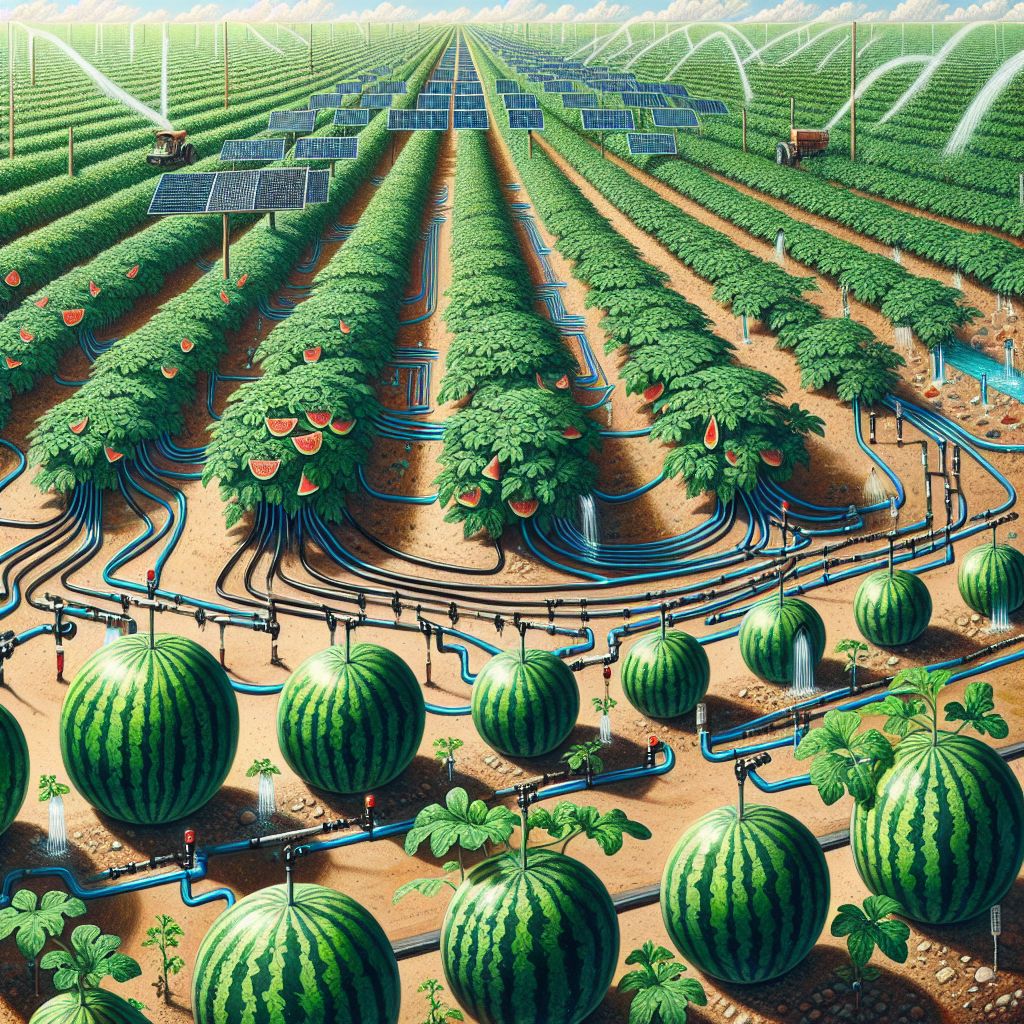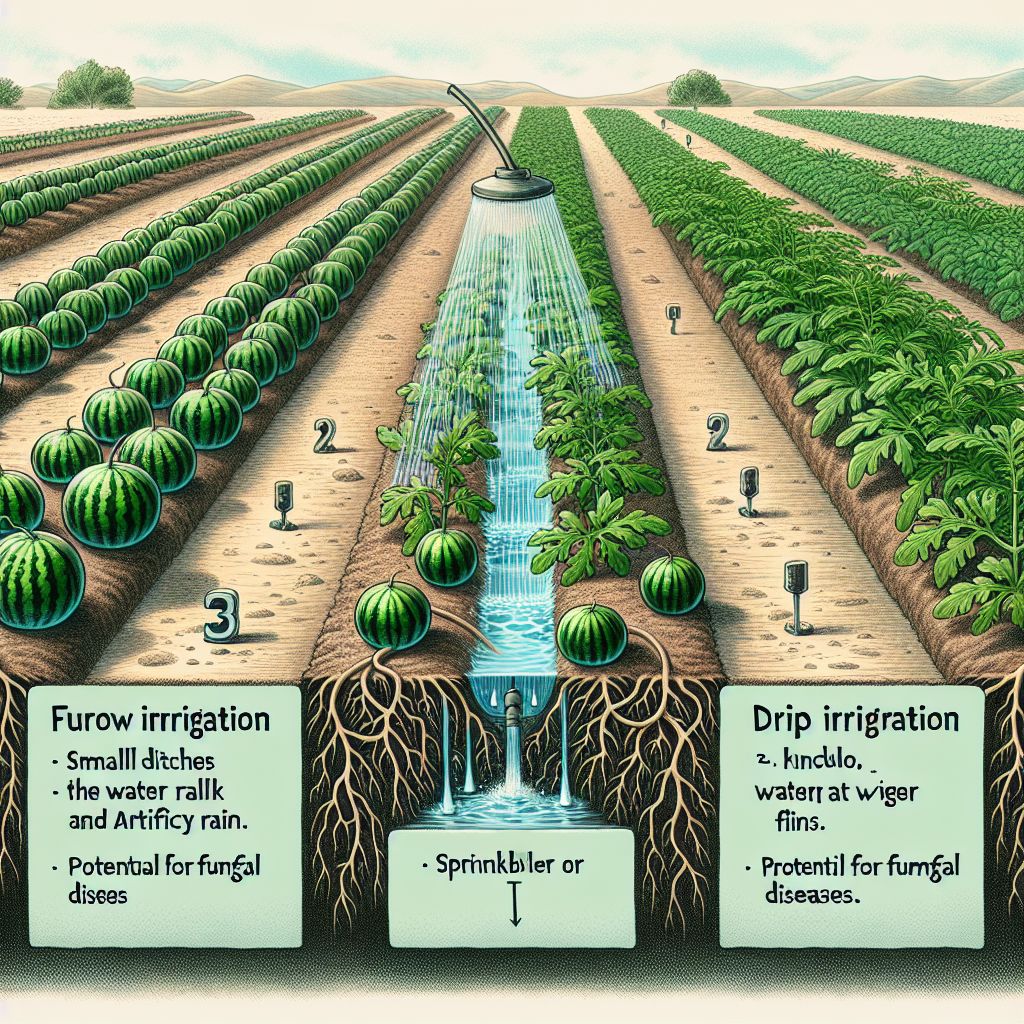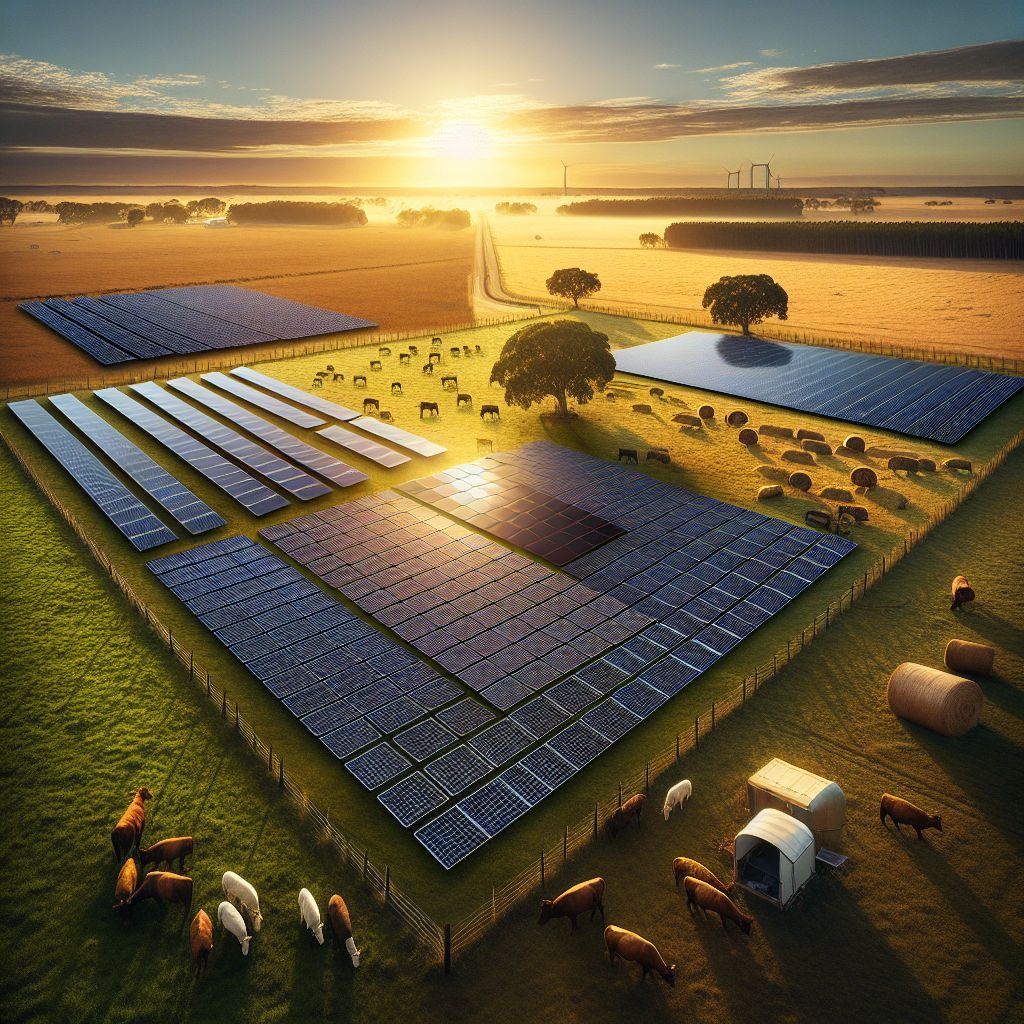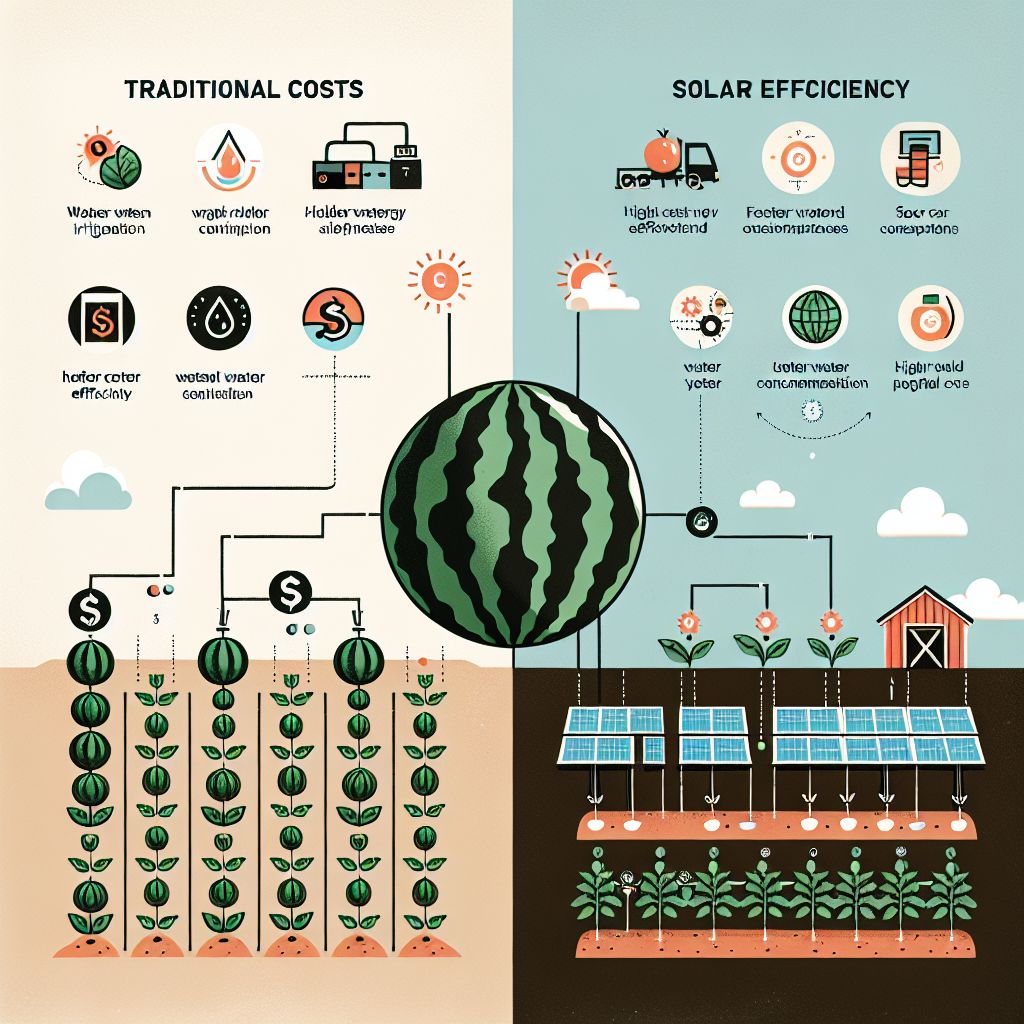
Key Takeaways
For watermelon farming, solar irrigation systems are a sustainable and cost-effective solution.
It’s crucial to understand the differences between traditional and modern irrigation methods for efficient water use.
The most efficient method for watermelon cultivation is drip irrigation, powered by solar energy.
Choosing the right solar panels and installation techniques can maximize water and energy savings.
Solar irrigation systems offer long-term benefits and can significantly increase farm profitability.
Why You Should Combine Solar Panels with an Irrigation System
Imagine using the sun’s power to not only grow your watermelons but also to water them. That’s a game-changer, isn’t it? One of the best decisions you can make for your farm is to combine solar panels with an irrigation system. Here’s why.
Cost Reduction and Sustainable Agriculture
To begin with, once you’ve installed the solar panels, the energy you get from the sun is free. This translates to significant savings on your electricity bills. Plus, harnessing solar power is an effective way to lower your carbon emissions, making your farming methods more sustainable. It’s a double victory for both your finances and the environment.
Uninterrupted Water Supply Fueled by Solar Energy
Watermelons thrive under the sun, but they also require a lot of water. With a solar-powered irrigation system, you can guarantee an uninterrupted water supply for your crops. No need to stress over power outages or varying energy costs. The sun will always be there, offering a dependable source of energy for your water needs.
Long-Term Savings for Watermelon Farmers
While solar panels may seem like a hefty investment initially, the long-term benefits are worth considering. Over time, the savings on energy will more than cover the initial investment. As energy prices continue to rise, your savings will increase. This means more money in your pocket from your delicious watermelon crop.

Various Irrigation Systems for Watermelon Farming
Furrow Irrigation: An Overview of Advantages and Disadvantages
Furrow irrigation is a traditional method of watering crops. It involves creating furrows or small ditches between the rows of watermelon plants and letting water flow through these furrows to reach the plants. This method is straightforward and does not require complex equipment, but it is not the most water-efficient. It can lead to significant water loss due to evaporation or runoff, and it does not always provide uniform water distribution to the plants. For those considering more sustainable and efficient options, exploring solar irrigation system components may offer valuable insights.
Understanding Sprinkler Irrigation: Is it Right for Watermelons?
Sprinkler systems are essentially artificial rain. They have the ability to cover a large area and can effectively keep your watermelons watered. However, they can also be somewhat inefficient. Water can evaporate before it even reaches the ground, particularly on warm days. Additionally, water droplets on the leaves can lead to fungal diseases, which is not ideal for your crop.
The Benefits of Drip Irrigation in Watermelon Farming
Let’s dive into the world of drip irrigation. This is the champion of watering methods for watermelons. Drip lines provide water directly to the root of each plant. This ensures minimal water waste, and each watermelon receives the precise amount of water it requires to flourish. It’s an efficient method, decreases the likelihood of disease, and when paired with solar energy, it’s incredibly economical.
Here is a table summarizing the pros and cons of different irrigation systems for growing Watermelons:
|
Irrigation System |
Pros |
Cons |
|---|---|---|
|
Drip Irrigation |
– Efficient water usage, minimizes evaporation and runoff. 1, 3, 4 |
– Initial installation can be expensive. 1, 3 |
|
Sprinkler/Overhead |
– Inexpensive to install. 1, 4 |
– Promotes foliar diseases on pepper plants. 1, 4 |
|
Furrow/Flood |
– Simple system, low installation cost. 1, 3 |
– Very high water usage. 1, 3 |

Comparing Costs and Efficiency: A Look at Traditional (Furrow and Sprinkler) Versus Modern (Drip) Irrigation Systems for Watermelon Farming
Irrigation is all about efficiency. We’re going to compare traditional and modern irrigation systems to see how they measure up when it comes to growing watermelons on a farm.
Comparing Water Consumption and Crop Output with Different Systems
It’s as simple as it gets – the less water you squander, the more efficient your system. Furrow irrigation can consume up to 50-70% more water than drip systems. And while sprinkler systems might appear efficient, they can lose a significant amount of water to wind and evaporation. Drip irrigation, on the other hand, can improve water efficiency by up to 90%. That’s a significant amount of water saved! And when it comes to crop output, efficient water use translates to healthier plants and potentially more watermelons to sell.
Upfront and Ongoing Costs
When it comes to the bottom line, furrow and sprinkler systems often have a lower upfront cost compared to drip systems. However, don’t be misled by the initial investment. Drip systems tend to be less expensive to maintain over time, and the reduction in your water bill can quickly offset the higher initial cost. Additionally, the inclusion of solar panels can lead to significant energy cost savings.
Understanding the Impact on Farm Earnings
What does this mean for your farm’s financial health? Investing in a modern, solar-powered drip irrigation system can lead to substantial savings and increased profits over time. With lower water and energy costs, you’re looking at a more sustainable and profitable farming operation. But it’s not just about saving money – it’s about making sure your farm can continue to flourish for many more years.

Various Solar Panels to Consider for Your Watermelon Farm’s Irrigation System
It’s important to choose the right solar panels for your irrigation system. You need a reliable source of power that can meet the needs of your farm. There are a few different solar panels to choose from, each with its own advantages.
When choosing solar panels, it’s important to consider their efficiency, price, and durability, as well as how much space you have available on your farm. It’s also worth considering the climate in your area, as some panels work better in certain weather conditions than others.
Monocrystalline solar panels: These panels are known for their high efficiency and long lifespan, but they are also more expensive.
Polycrystalline solar panels: These panels are a cheaper option, but they are slightly less efficient.
Thin-film solar panels: These panels are flexible and lightweight, making them ideal for large areas with less load-bearing capacity.
Monocrystalline Panels: The Best Choice for Efficiency
If you want the most efficient solar panels and are willing to pay for them, monocrystalline solar panels are the best choice. They are made from a single, pure crystal structure, which allows them to convert more sunlight into electricity than other types of panels. This means you will need fewer panels to power your irrigation system, which saves space and reduces the overall footprint of your setup.
Polycrystalline Panels: Affordable and Dependable
If you’re searching for an option that offers both affordability and effectiveness, polycrystalline panels are a good pick. They’re crafted from pieces of silicon crystals that have been melted and fused together, making them less costly to manufacture. Even though they’re not as efficient as monocrystalline panels, they still deliver consistent results and are an excellent choice for farms with a more limited budget.
Thin-Film Panels: Versatile and Light
Thin-film solar panels are a cutting-edge option for farms with a lot of space that isn’t being used. They can be spread out like a rug over large areas, such as the roofs of warehouses or unused land. These panels are not as efficient as crystalline ones, but their light weight and adaptability make them a good fit for a range of uses where traditional panels might not work.
Right below is a table looking at all the different solar panel options:
|
Solar Panel Type |
Efficiency Range |
Advantages |
Disadvantages |
|---|---|---|---|
|
Monocrystalline |
17-22% |
Highest efficiency, space-saving, long lifespan. 2 | |
|
Polycrystalline |
15-17% |
Lower efficiency, requires more space. 2 | |
|
Thin-Film |
10-13% |
Lightweight, flexible, good temperature coefficient. 2 |
Lowest efficiency, requires large area. 2 |
|
Portable Solar Panel Systems |
Varies based on panel type |
Designed for irrigation needs, easy to move and relocate. 1, 3 | |
|
Hybrid Solar Panels |
Varies based on components |
Can combine solar with other energy sources like wind, increased reliability. 4 |
More complex system, higher cost. 4 |
Monocrystalline panels provide the highest efficiency in a compact area but at a higher upfront cost (2, 3). Polycrystalline panels offer a balance of efficiency and cost (2, 3). Thin-film panels have lower efficiency but perform better in high temperatures (2). Portable solar panel irrigation systems allow flexibility in placement and relocation as needed (1). Hybrid systems increase reliability by combining solar with other renewable sources but add complexity (4). The optimal choice depends on factors like available space, budget, local climate conditions, and specific irrigation requirements for the Watermelon.
Choosing the Best Solar Panel for Your Irrigation System
When choosing solar panels, keep these factors in mind:
Efficiency: How efficiently do the panels convert sunlight into electricity? Look for panels with a high efficiency rating.
Durability: Farming can be rough on equipment. Choose panels that can withstand extreme weather and are known for their durability.
Warranty: A solid warranty can give you peace of mind. Choose panels that come with a good guarantee.
Cost: While you don’t want to compromise on quality, you also need to consider your budget. Balance the cost with the panel’s performance and warranty.
Take monocrystalline solar panels as an instance, they are incredibly efficient and long-lasting, which is why farmers often choose them. They might be more expensive initially, but the energy savings over time can be significant.
After you’ve picked out your solar panels, it’s time to install them and start enjoying the advantages of solar-powered irrigation.
Setting Up Solar Panels in Farming Environments
Setting up solar panels on your farm isn’t as difficult as you may think. Here are some tips to make the installation process easier:
Work with an installer who has experience working in farming environments.
Find the optimal location for your panels. They should receive the most sunlight and be near your irrigation system.
Ensure your panels are angled properly to receive the most sunlight during the day.
Consider the future growth of your farm – you may want to increase your solar setup as your farm expands.
Optimizing Power Efficiency through Solar Panel Utilization
After installing your solar panels, the next step is to maximize their utility. This can be achieved by using a smart controller that adjusts the watering schedule in response to weather and soil moisture levels. This way, you can make the best use of water and solar energy, guaranteeing that your watermelons receive the perfect amount of water at the perfect time.

Comparing the Costs and Efficiency of Traditional and Solar Irrigation Systems for Watermelon Cultivation
Let’s now take a moment to compare the costs and efficiencies of traditional irrigation systems with those that are solar-powered. It is crucial to take a broader view to fully appreciate the benefits that solar irrigation can bring to your watermelon farm.
Assessing the Financial Benefits of Solar Irrigation Systems
Choosing a solar irrigation system isn’t just about being eco-friendly – it’s also a savvy financial choice. Although the initial costs may be higher than conventional systems, the return on investment (ROI) can be quite substantial. The savings from lower water and energy bills can mean that you recoup your initial investment within a few years. After that, it’s pure savings – and more cash in your pocket.
Keep in mind, agriculture isn’t only about today. It’s about securing a sustainable and lucrative tomorrow. Solar irrigation systems are a way to invest in that future, allowing you to cultivate tasty watermelons for many years ahead while also being good stewards of the earth.
The world of agriculture is being transformed by the latest developments in solar-powered irrigation technology. These cutting-edge systems are making farms more self-sufficient by reducing their dependence on grid power and harnessing the plentiful energy of the sun. Solar irrigation systems are more than just a fad – they’re a sustainable solution that’s here for the long haul, making them a must-have for any watermelon farmer seeking to streamline their operation.
Case Studies: The Impact of Solar Systems on Watermelon Agriculture
Consider a watermelon farm in California that transitioned to solar-powered drip irrigation. They experienced a 20% increase in crop yield and a 75% decrease in water consumption. Similarly, an Arizona farm now uses solar panels to power all their irrigation needs, cutting their energy expenses in half. These stories are not only motivating, but they also demonstrate the real-world advantages of solar irrigation systems.
This table compare the pros and cons of conventional irrigation systems and solar-powered irrigation systems:
|
Aspect |
Conventional Irrigation System |
Solar-Powered Irrigation System |
|---|---|---|
|
Pros |
No ongoing energy costs, uses free solar power. 5 | |
|
Simple installation and maintenance. 1 |
Environmentally friendly, reduces carbon footprint. 3 | |
|
Reliable water supply even during power outages. 5 | ||
|
Long lifespan of solar panels (25-30 years). 5 | ||
|
Cons | ||
|
Susceptible to power outages. 5 |
Requires some technical knowledge for installation/maintenance. 3, 4 | |
|
Environmental impact from energy use. 3 |
Risk of over-abstraction of groundwater if not managed properly. 3, 4 | |
|
Potential for water waste/inefficiency. 1 |
Final Thoughts: Should You Switch to a Solar Irrigation System for Watermelon Cultivation?
Is it worth switching to a solar irrigation system? Definitely. The benefits of less water consumption, reduced energy bills, and increased crop yield make it an obvious choice for watermelon growers. The upfront cost may be significant, but the long-term savings and positive environmental impact make solar irrigation systems a smart investment for any farmer who wants to prepare for the future.
Questions You Might Have
Here are some questions you might have about solar irrigation systems for growing watermelons.
Why are Solar Panels with Irrigation Systems Considered Sustainable?
Solar panels are considered sustainable because they use renewable energy from the sun, which reduces our dependence on fossil fuels. They produce clean energy, which reduces greenhouse gas emissions. When used in conjunction with an irrigation system, they help save water – a valuable resource. This makes the whole process of growing watermelons more sustainable.
Can All Irrigation Systems be Powered by Solar Panels?
Indeed, solar panels have the capacity to power a wide range of irrigation systems, including the conventional furrow and sprinkler systems as well as the more efficient drip irrigation systems. The main requirement is to have a suitably sized solar array and battery storage system to guarantee a steady power supply, irrespective of the irrigation technique.
Furrow irrigation is a simple system that might use less energy.
Sprinkler systems could require a bit more power due to their pumping mechanisms.
Drip irrigation systems are the most energy-conserving and pair well with solar power.
How Does Weather Impact Solar Irrigation Systems?
Weather can affect the effectiveness of solar irrigation systems. Cloudy or rainy days could decrease the power production of solar panels. But, with the right planning and backup battery systems, you can ensure that your irrigation needs are met even when there’s less sun.
How Much Does a Solar Irrigation System Cost?
The initial cost of a solar irrigation system can be quite different depending on the size of the system and the type of irrigation you use. Generally, you could be looking at anything from a few thousand dollars for smaller systems to tens of thousands for bigger farms. Keep in mind, it’s not just about the price but also the long-term savings and the increase in farm profitability.
For a medium-sized watermelon farm, the initial investment for a solar irrigation system might be around $20,000 to $40,000, which includes solar panels, pumps, batteries, and installation costs. Keep in mind that incentives and rebates can significantly lower these upfront expenses.
How Long Does It Take to See Savings from a Solar-Powered Irrigation system?
The timeline to see savings from a solar-powered irrigation system can vary. Most farmers start noticing reduced energy bills immediately after installation. The return on investment typically occurs within 3 to 5 years, depending on factors such as system size, energy costs, and incentives. After that, it’s pure savings and more efficient, sustainable farming for the life of the system, which can be 25 years or more.







Leave a Reply